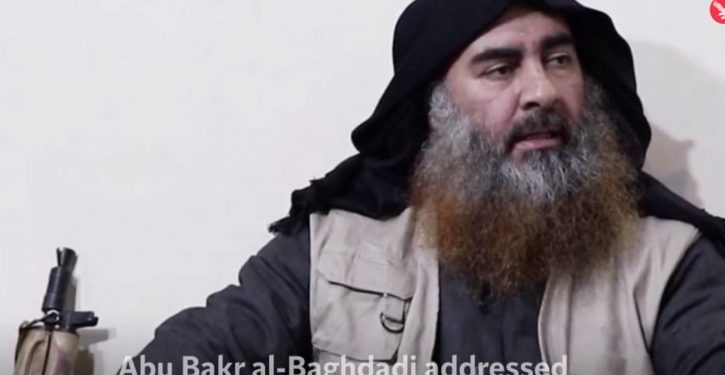
This event is getting the full article treatment because it was heralded by a cryptic tweet from President Trump a short time ago.
Something very big has just happened!
— Donald J. Trump (@realDonaldTrump) October 27, 2019
The something big, if we go by a report Newsweek just put out, is that ISIS founder Abu Bakr al-Baghdadi was killed in the last few hours in a U.S. special forces action in Idlib province in northwestern Syria.
Will this presidential election be the most important in American history?
There are some immediate oddities in that. First, many analysts consider the likelihood low that Baghdadi was actually in Idlib province. (As Newsweek reported, the Russians have sworn he’s not.) Although there is a concentration left there of Sunni opposition forces, in enclaves defying the Assad regime and its Russian and Iranian backers, ISIS has not been thought to have an organized or effective presence there for some time.
Frankly, that makes it more likely in my mind, not less, that Baghdadi could have been hiding out there. He wouldn’t want to be where there’s a known ISIS presence. That would just attract undesirable attention.
But the other oddity on a quicklook is that U.S. special forces went into Idlib to execute this operation. There were reports from locals circulating on Twitter earlier that U.S. forces had entered for an apparent operation of some kind; seemingly, a short-lived tactical action. And it’s not unprecedented. But we don’t wander Idlib unimpeded. That’s Assad/Russia territory, being held – still on an active combat basis – by their forces against the remnants of rebel forces.
The question would be who stood aside for us to do this, assuming the reporting is true. Candidates are Russia [pretty certain; see UPDATE 2 below] and Turkey (less likely, as Turkey’s geographic reach in Idlib is much more limited and contingent on Russian sufferance).
At the moment, it’s all a whole lot of speculation. Baghdadi has been thought to be somewhere in Syria or Iraq [see UPDATE reporting Barisha, Syria, below], although his health reportedly hasn’t been good (a consequence of multiple attempts to kill him in the last few years). He last issued an audio update to his followers on 16 September.
A clue from an analytical observation about that speech may in fact have indicated Baghdadi was in Idlib. The Diyaruna report quotes the analyst, Wael Abdul-Muttalib, as saying “al-Baghdadi appeared to be trying to win over other extremist elements or open lines of dialogue with elements of al-Qaeda and al-Nusra Front, which now makes up the core of Tahrir al-Sham.”
Hayat Tahrir al-Sham is the main group now still mounting a Sunni rebel front in Idlib, and is largely composed of the one-time al-Nusra Front. The wording of Baghdadi’s last audio update may thus have been a clue on a couple of matters: where he was, and where he thought ISIS’s future might lie — i.e., in a loose alliance with Tahrir al-Sham.
The BBC map, added in haste, is from June and now a bit outdated. Its utility is mainly to demonstrate the general area in Idlib where Baghdadi might have been, and what potential access points would have been for U.S. special forces. Assuming the tacit agreement for the operation came from Russia, the dark orange would be the starting place. (If we helo’d in and out, it sure looks like we would have done it from Turkey, right across the border to the west.)
UPDATE: A new tweet in the last hour indicates the location of the special forces op was Barisha. The map has been updated to show its location. See the tweet below for video of some of the reported damage in the aftermath.

https://twitter.com/MhdAGhanem/status/1188322663946686464
UPDATE 2: Al Arabiya reports Iran has acknowledged being informed of Baghdadi’s death. That would indicate it occurred on the territory patrolled by Assad and Russia, with the communication to Iran coming from the Assad regime; i.e., at the military or diplomatic level in Damascus.
Iran was informed of ISIS leader al-Baghdadi’s death, Reuters reports citing two Iranian officials.https://t.co/8q7zxrhtrD pic.twitter.com/1IqvQvQalE
— Al Arabiya English (@AlArabiya_Eng) October 27, 2019
Perhaps it’s moot now. Multiple sources have indicated there will be an announcement Sunday morning. Until then, there’s little point in further speculation.
Acc to well placed military sources, a high value ISIS target believed to be Abu Bakr al Baghdadi was killed by US led forces in Idlib, Syria. US military cannot yet confirm identity of deceased target. DNA tests underway. POTUS expected to make an announcement Sunday morning.
— Jennifer Griffin (@JenGriffinFNC) October 27, 2019
Also, I have no idea if this report is true.
UPDATE: ISIS leader #Baghdadi is believed to have detonated his own suicide vest, multiple sources confirm to @DefenseOne. #Syria
— Defense One (@DefenseOne) October 27, 2019
There is a significant point worth making now, however. ISIS has been an experiment and an example of territorial terrorism: the quest to consolidate territory under a jihadi flag, rather than just hop from one place to the next blowing things up. I doubt we’ve seen the last of the ISIS-type approach. But what we’ve seen at this point is how investing in territory is very costly for a group like ISIS.
Unlike al-Qaeda, ISIS now has thousands of “fighters” and their family members being held in prisons and special camps. That’s a form of organized defeat and exhaustion of options that al-Qaeda can’t be affected by.
The reason for pointing this out is that the ISIS model makes it harder to recover from the death of the leader. Where al-Qaeda would just pick a new one and keep moving, ISIS has stopped moving, at least in Syria and Iraq. ISIS is kettled up in holding pens now, and probably leaderless. The force and its animating purpose have no fallback – no driving concept of a next step. Al-Qaeda can always just start planning a new attack, if the infrastructure that was setting up the last one is interdicted.
Can ISIS offshoots in other places – Afghanistan, Pakistan, Libya, the Philippines – emerge in a centralized leadership role and retool? Syria had a very distinct apocalyptic significance for ISIS from the beginning; at some point, the group cannot remain “ISIS” if it has no vision for getting back to Syria. But there is far less prospect of that now than there was of enlarging a caliphate-driven “ISIS” from central and northern Iraq and eastern Syria, back in 2013.
Tahrir al-Sham has taken over the “Sham” portfolio, to an extent. ISIS never meant “Islamic State of Iraq and Syria”; it always meant “Islamic State of Iraq and al-SHAM.” An ISIS without Baghdadi has lost position to claim dibs on being the defender or re-conqueror of al-Sham – the land of “the left hand,” defined 1300-odd years ago, when one is facing the rising sun in Mecca. “Sham” is the central purpose of ISIS; Sham, with theological significance going back to Abraham or before, is where the events of the Sunni apocalypse are supposed to unfold.
But the core composition of Tahrir al-Sham is itinerant jihadis, not territorial administrators in the manner Baghdadi conceived of. The momentum for ISIS-like magic-caliphating has bled away. That leaves on the stage the already existing nation-states with radical, caliphate-seeking rulers – and with restive, divided peoples. It leaves Iran and Turkey.
If Baghdadi is confirmed dead, this may indeed be a very big thing that just happened.




